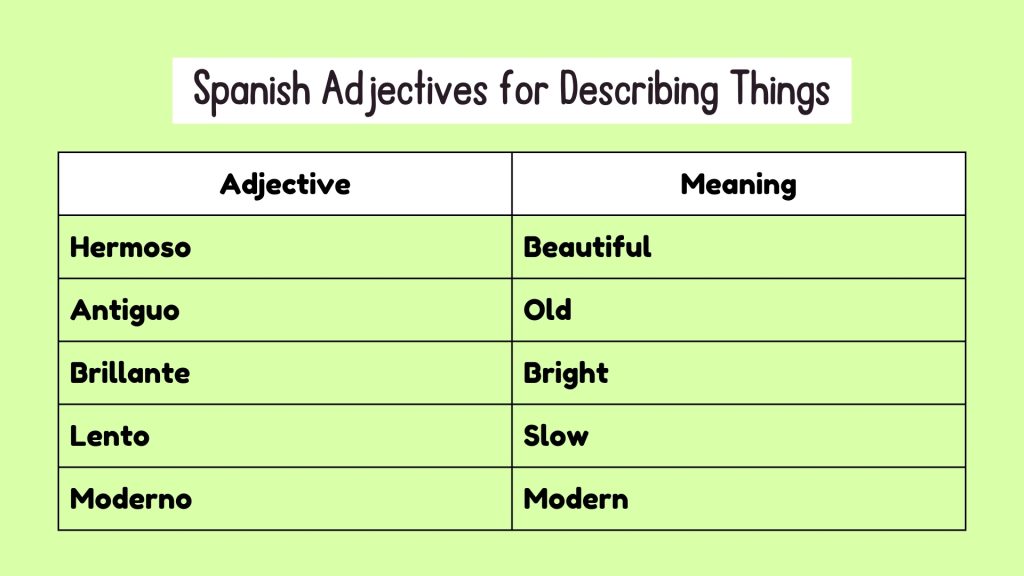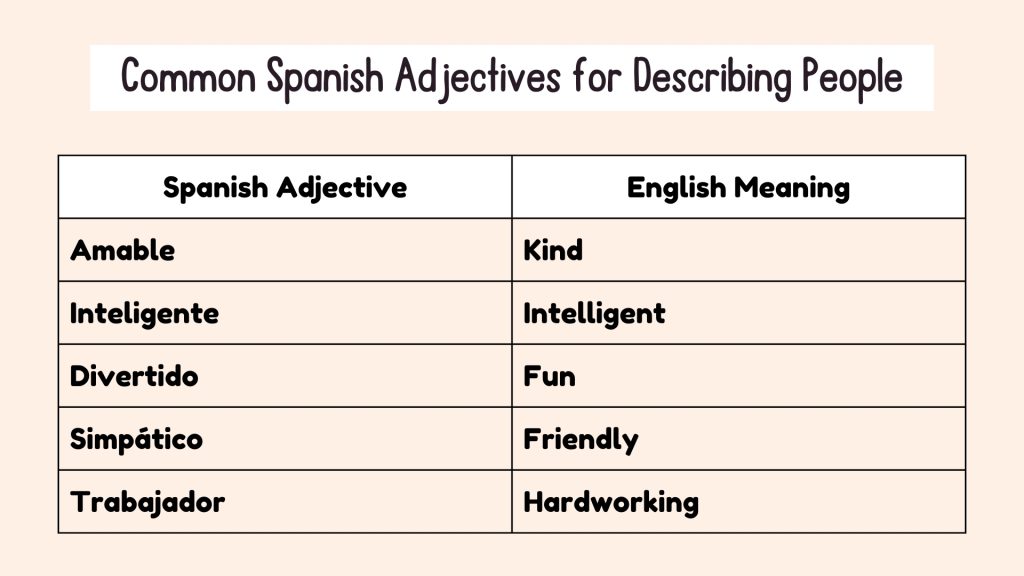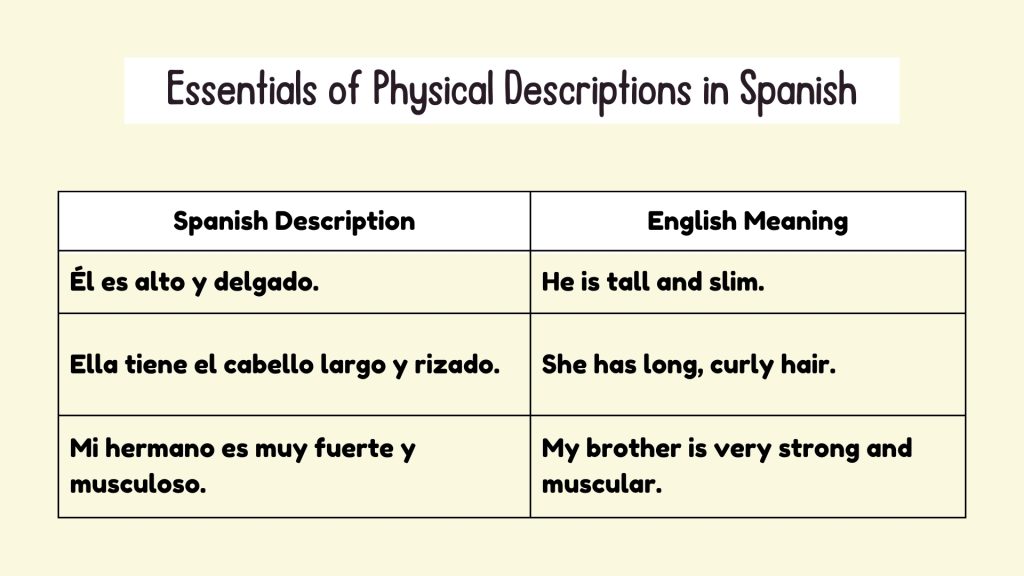Studying Spanish adjectives shows us how language influences our views. These words change to match gender and number, and their placement can highlight different features. Usually, adjectives come after the noun, but sometimes they go before it to stress certain traits.
This flexibility in language is fascinating. For example, the word ‘grande’ becomes ‘gran’ before a noun to emphasize greatness. Understanding these details helps us better appreciate and express in Spanish.
This deeper look into language shows its power and beauty.
Spanish Adjectives for Describing Things
When we dive into Spanish adjectives, we need to grasp a couple of things. First off, where do these adjectives go in a sentence? Unlike English, they usually follow the noun they describe. But, there are exceptions. Understanding this helps us speak and write Spanish more clearly.

This is super useful when you want to paint a clear picture of someone’s personality or mood in Spanish. It’s all about choosing the right word to capture the essence of the character or emotion you’re talking about.
| Adjective | Meaning | Example Sentence |
|---|---|---|
| Hermoso | Beautiful | La casa es muy hermosa. |
| Antiguo | Old | El coche es antiguo. |
| Brillante | Bright | La lámpara es brillante. |
| Lento | Slow | El tren es lento. |
| Moderno | Modern | Este edificio es moderno. |
Improve Your Spanish Pronunciation with Spanish Word with ‘RR’
What Are Adjectives in Spanish?
Spanish adjectives describe nouns. They change form based on the noun’s gender and number. This means they help tell us more about things like size, color, and shape.
Where Do Spanish Adjectives Appear in a Sentence?
Understanding where to put adjectives in Spanish is crucial if you want to get the grammar right. Most of the time, adjectives in Spanish come after the nouns they describe. This is the opposite of how it’s usually done in English.
Putting the adjective after the noun can highlight qualities, point out specific features, or clear up what we mean. But sometimes, adjectives come before the noun. This switch can make the description feel more emotional or personal, changing how the sentence feels.
| Sentence Structure | Example |
|---|---|
| Noun + Adjective | El perro grande (The big dog) |
| Adjective + Noun (for emphasis) | La gran casa (The big house) |
How to Use Adjectives in Spanish Sentences?
To use Spanish adjectives correctly, you need to remember a couple of simple rules.
First, make sure the adjective matches the noun in both gender and number. This means if the noun is feminine and plural, the adjective should be too.
This helps keep your Spanish clear and correct, whether you’re writing or speaking.
| Example Adjective Agreement | Masculine | Feminine |
|---|---|---|
| Singular | el perro bonito (the pretty dog) | la casa bonita (the pretty house) |
| Plural | los perros bonitos (the pretty dogs) | las casas bonitas (the pretty houses) |
Are There Exceptions in Spanish Descriptive Adjectives?
While many Spanish adjectives follow standard rules of agreement, there are a few that don’t. For example, the adjective ‘grande’ becomes ‘gran’ before singular nouns.
- Adjectives with Different Meanings Depending on Placement:
- Gran means “great” before a noun, but “big” after.
- Viejo means “old” when placed after the noun, but “elderly” when placed before.
- Irregular Adjectives: Some adjectives have irregular forms when changing for gender and number.
- Example: Bueno becomes buena for feminine singular nouns.
Common Spanish Adjectives for Describing People
Let’s talk about some common Spanish adjectives used to describe people.

| Adjective | Meaning | Example Sentence |
|---|---|---|
| Inteligente | Intelligent | Él es muy inteligente. |
| Simpático | Friendly | Ella es simpática. |
| Timido | Shy | Juan es tímido. |
| Cariñoso | Caring | Mi madre es cariñosa. |
| Travieso | Mischievous | El niño es travieso. |
Explore the collection of 120+ hard words will sharpen your speech.
Essentials of Physical Descriptions in Spanish
When you’re learning to describe how people look in Spanish, you need to know a few key adjectives and how to use them correctly.

| Feature | Adjective | Example Sentence |
|---|---|---|
| Height | Alto/a, Bajo/a | Ella es alta. (She is tall.) |
| Hair | Castaño/a, Rubio/a | Él tiene el pelo castaño. (He has brown hair.) |
| Eyes | Ojos azules/verdes | Tiene los ojos verdes. (She has green eyes.) |
| Build | Delgado/a, Gordo/a | Es un hombre delgado. (He is a thin man.) |
| Age | Joven, Viejo/a | Mi abuelo es viejo. (My grandfather is old.) |
Conclusion
To put it simply, Spanish adjectives are key for detailed and vivid descriptions. They change their form based on the gender and number of the nouns they relate to, making your communication more specific and rich.
Usually, these adjectives come after the nouns, which makes things clearer. Sometimes, changing their position can highlight certain qualities.
Getting these grammar rules down is crucial if you want to speak Spanish fluently and expressively.
To read more such articles, keep visit Lingua Viva .
Carolina is a charming and lively member of Lingua Viva with 11+ years of teaching experience. She loves to teach students appropriate ways to communicate effectively in Spanish without the fear of making mistakes. She holds a professional teaching license and has a graduate degree with emphasis in Foreign Language.











